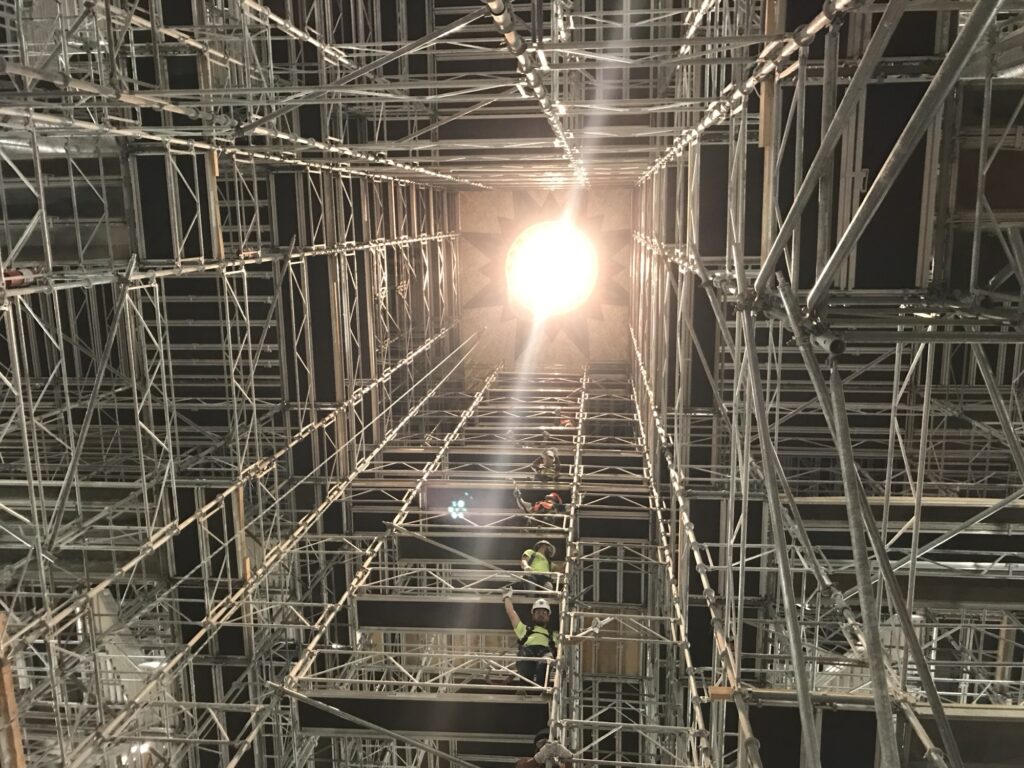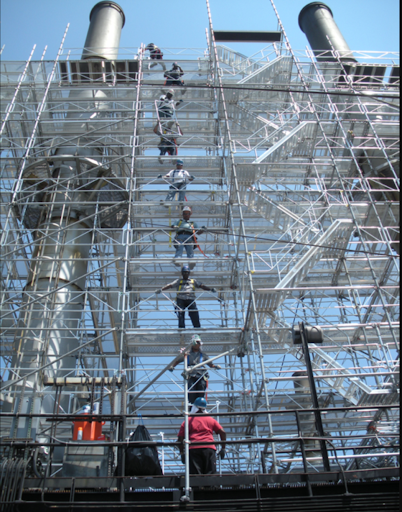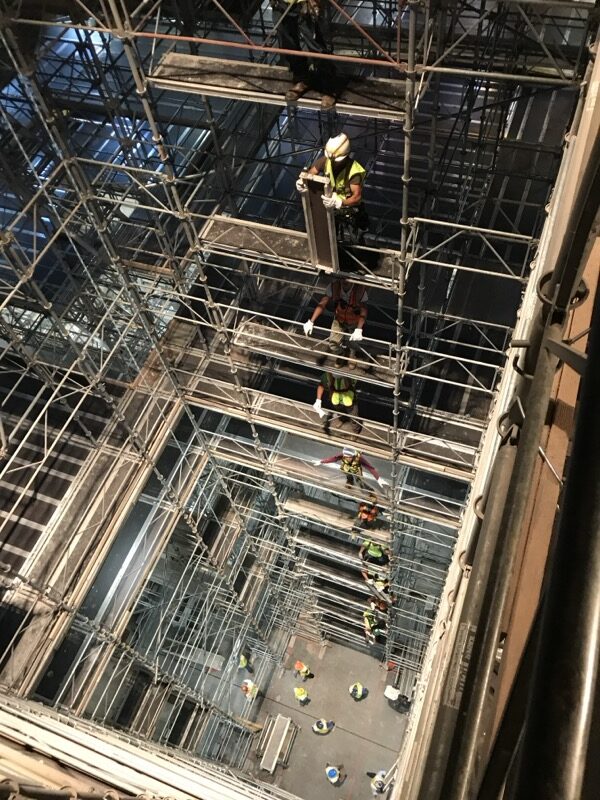
Safety is a top concern when working at height. Alarmingly, scaffolding-related incidents lead to approximately 4,500 injuries annually. Accidents frequently cause physical injuries and also lead to serious financial issues. This includes lost workdays costing an estimated $90 million, potential fines, and higher insurance premiums.
Fortunately, there are many ways for companies to protect their employees from these preventable accidents. The following scaffolding safety tips will help reduce the risks of an accident when working at heights.
Personal protective equipment (PPE) is necessary when working in any industrial or construction setting, especially at height. Wearing a hard hat on scaffolds is crucial to protect against injuries from falling objects. Non-slip footgear and especially proper fall arrest equipment are also essential when working on platforms.
Incorporating hand-protecting gloves and tool-tether lanyards is essential to further enhance working-at-heights safety. Slip-resistant gloves improve tool grip, making workers less likely to drop them.
Tool tethering lanyards also securely attach tools to workers, preventing falls that could endanger others working below. This combination of fall protection equipment boosts safety and improves operational efficiency.
Manufacturers design scaffolding equipment with specific load-bearing capacities and load limits in mind. Your workers could be at serious risk of injury if you place excessive loads on scaffolding structures greater than the intended design capacity. Scaffold platforms might break, fail or collapse —causing potentially severe injuries for workers on or near the scaffolding. Fortunately, scaffolding components are designed with a 4 to 1 safety factor providing a significant capacity safety cushion, but it is always good to know what your scaffold structure load capacity actually is before putting concentrated loads on the decks.
Every industry has its own specific regulations and standards. Scaffolding regulations are generally governed by Federal OSHA for different Industry classifications and specific customer sites may also have project standards over and above OSHA, so research the specific OSHA, Industry and customer site requirements before constructing any platforms.
Building and using scaffold structures that are installed according to applicable standards and regulations can prevent accidents, employee risks and, at the very least, avoid liability for not meet necessary standards. In addition, as required in the Competent Person inspection requirement for all scaffolding users, your workers should be trained to recognize and minimize the risks and hazards of whatever type of scaffolding you’re using on your project.
Before setting up your work platforms, you must inspect all your materials beforehand. Make sure none of the parts have defects or damage that could compromise the structural integrity of your scaffolds. Mismatching components can pose a significant scaffolding hazard and lead to structural failure.
Follow the instructions provided by the manufacturer when building your scaffold. Check the types of bracing, fasteners and anchor requirements to ensure that you’re erecting the scaffold according to the manufacturer’s instructions. Do not take shortcuts or improvise your own design.
You also want to ensure the work area is entirely safe when building your scaffold. A level ground surface works best (if possible), but with the right components, scaffolding can be safely built on sloped terrain. If working near power lines, certain safety guidelines apply, but at a minimum you must stay 10-feet or more from the power lines. Always consult a qualified scaffolding expert when working near power lines. In addition, regulations require a Competent Builder Person to be present and supervise scaffolding erection and dismantle work. A competent person is someone who has received OSHA-approved training, scaffolding manufacturer equipment training, and has the accompanying title and authority assigned by their company.

Be sure to check for the following:
The need for inspections doesn’t go away after you’ve erected the scaffolding. Check the area regularly for hazards, defects, debris, or other factors that could cause a problem.
Competent User Person’s conduct inspections at the start of each workday to confirm the area is hazard-free for that shift. Consider using scaffolding safety check-lists to ensure all safety elements are confirmed every day.
Always keep vehicles and heavy equipment clear of the scaffold base. Setting up barriers can keep the whole structure from toppling. In situations when it’s necessary to have heavy equipment nearby. make sure the equipment has clearance.
“Good housekeeping” isn’t just a magazine in the supermarket checkout line. Maintaining cleanliness and order on scaffolds is crucial for safety. Ensuring the scaffolding is free from tools, debris, excess scaffolding planks, or trash is essential.
These items can create tripping hazards or add undue stress to the scaffold structure, potentially leading to a collapse. Regularly schedule clean-up sessions and encourage workers to tidy their working areas to prevent these risks.
You want to ensure the conditions are safe when working at height. Working during harsh weather conditions or other environmental hazards can increase the risk of serious injury. For instance, high winds could risk injury to those working on the scaffold. If a storm has brought down a power line, that could also create a scaffolding hazard.
In addition to wind, weather conditions like heavy rain, lightning, snow, and ice pose significant risks to scaffold safety. OSHA guidelines advise against climbing, using, or erecting scaffolds.
Workers should know these hazards and avoid using the scaffold during weather events. Monitoring forecasts and enforcing weather safety rules ensures a hazard-free workplace.
Learn how Scaffolding Solutions mitigated high wind concerns when installing scaffolding on an aviation hangar.
Working with fully licensed staff and contractors helps prevent injuries. This ensures everyone on site understands proper scaffolding practices. Obtaining a license requires education, training time, and hands-on experience. This rigorous preparation enables your team to perform their duties competently and safely.
Scaffold safety requires careful attention to climbing practices. Workers must maintain three points of contact with the scaffold at all times—either two hands and one foot, or one hand and two feet.
Scaffold erectors can climb vertical and horizontal bars during assembly or disassembly if they securely tie themselves off. All other users should stick to ladders, ramps, or stair towers for climbing.
Scaffolding tags help identify whether or not a scaffold is safe to use. A competent person (as defined by OSHA) must inspect and tag the scaffold structure. There are three different types of scaffolding tags:
Green scaffold tags—If you see a green tag on a scaffold, a competent person has inspected it and verified it is safe for use. Each access point should have a green tag after the completed initial inspection.

Yellow scaffold tags—Yellow tags indicate that scaffolds have undergone modifications to their structure or components to fulfill particular work requirements. However, these changes have the potential to introduce new hazards or risks. The yellow tags outline special safety precautions or usage guidelines that all users must follow.
Red scaffold tags—If you see a red tag, it means there is danger and the scaffold is unsafe for use. Workers often use these tags when they’re erecting or dismantling the scaffold.
Use Ground Fault Circuit Interrupters (GFCIs) for all electrical tools used on scaffolds. GFCIs greatly reduce the chance of electric shock. Requiring slip-resistant gloves and tool lanyards as personal protective equipment also improves safety. Attaching tools prevents them from falling and injuring those below.
Understanding what causes damage to scaffolding is crucial for maintaining a safe work environment. Workers can damage scaffolding by forcibly hitting it during manual labor or through contact with vehicles/motorized equipment. Exceeding the structure’s maximum load capacity can also compromise its integrity.
Environmental elements like rust due to oxidation can weaken the scaffold’s structure. Conducting regular inspections and not exceeding weight limits helps minimize these hazards and ensures the scaffolds remain safe and functional.
Scaffolding integrity is vulnerable to more than just damage from excessive weight. It can also suffer damage from forceful impacts, like manual labor or motorized equipment. Environmental elements, such as rust, can weaken the structure over time. Regular inspections for these types of wear and tear are crucial to maintain scaffolding safety.
Setting a safe distance between scaffolding and heavy equipment is essential to prevent accidents. As a guideline, keep a minimum distance of at least 10 feet away from all heavy machinery.
For larger vehicles and their greater swinging/reaching range, set up an exclusion zone 20 feet away or more. Maintaining this protective buffer prevents hazardous collisions that could compromise the scaffolding and endanger workers.
Safe climbing practices are essential for scaffold safety. All scaffold users must adhere to designated climbing methods to prevent falls and injuries. The only permissible ways to ascend and descend scaffolding are through ladders, ramps, or stair towers. This ensures maximum safety and compliance with established safety standards.
Scaffold erectors have specific guidelines for climbing during the erection or dismantling of the scaffold. They can climb vertical legs and horizontal bars, but only in these circumstances and while adequately tied off. This precaution is necessary for their safety and the scaffold’s structural integrity.
All other workers should only use approved climbing components. They should not climb cross braces, diagonals, bars, vertical legs, guardrails, or other non-designated parts.
Adhering to these protocols is vital for maintaining a safe work environment and minimizing the risk of accidents. By restricting climbing to designated areas and methods, the safety of all workers involved with the scaffold is more assured.
Staying up-to-date with the latest safety standards and practices is a continuous responsibility. Regularly reviewing evolving safety standards and equipment with all personnel creates a culture of constant learning.
For example, repeatedly referencing OSHA’s scaffolding safety guidelines will keep you up-to-date on the latest federal regulations. Bookmark their eTool page and have your designated competent person review it regularly for changes.
Training staff to recognize scaffolding hazards and follow safety measures significantly reduces accidents and liability. Providing them with easy access to tools and personal protective equipment for further accident prevention is vital.
At Scaffolding Solutions, we are committed to scaffold safety. Our experienced team stays current on the latest standards and regulations for compliance. Our comprehensive training equips every crew member with the skills to erect scaffolding and identify potential hazards safely.
Click below to request a free quote for your upcoming scaffolding project. Our safety-focused services provide reliable scaffolding installations to keep your job site productive and accident-free.

